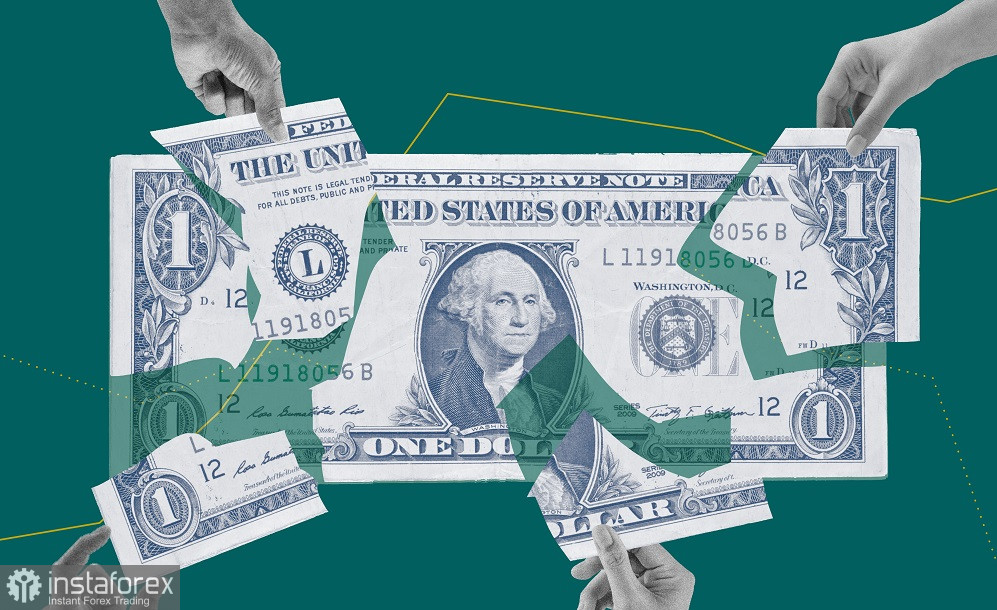At the start of the new trading week, buyers of the EUR/USD pair again tried to assert themselves above the level of 1.07. The corrective growth was over almost immediately. Remarkably, traders are showing amazing persistence. The instrument has been creeping up for the third week in a row. Traders are trying to close their long positions above the target of 1.0700. Each time, the price slips back to the area below 1.07.
At the end of last week, the pair dived lower thanks to the core PCE index. The most important inflation indicator for the Federal Reserve has stopped declining, thereby complementing the overall alarming picture. The main index of personal consumption expenditures in March came out at 2.8%, while most experts expected a further decline to 2.6%. Indeed, this is an alarming bell for the Federal Reserve. Over 5 months (from August to December inclusive), the PCE price index consistently went down. During this period, the annual PCE decreased from 4.3% to 2.9%. But this year, the index has come to a standstill. In January, it remained at the December level, in February it decreased marginally to 2.8% and ultimately remained at the same level in March.

Friday's report should be considered alongside other inflation indicators, which showed upward dynamics in February-March. For example, the headline consumer price index in March increased to 3.5% in annual terms, the strongest growth rate since September last year. The core index also entered the green zone: instead of another downtick to 3.7%, it remained at the February level of 3.8%.
Following these reports, the market's dovish expectations regarding the Fed's further policy moves have weakened. According to the CME FedWatch Tool, the likelihood of a rate cut in June is now 9%. The chances of a reduction in interest rates in July are also low (27%). As for September, the probability is 50/50 so far. At the same time, some analysts, in particular, economists from such heavyweights as Bank of America and Societe Generale, even admitted that the Federal Reserve would refrain from easing monetary policy this year.
The core PCE index, published last Friday, once again reminded traders of the impending difference between the Federal Reserve's and ECB's interest rates. Let me remind you that many ECB policymakers, in particular, Christine Lagarde, Francois Villeroy de Galhau, and Claes Noth, confirmed a likely rate cut in June last week in unison "if life does not present any surprises." The surprise could be an unexpected increase in inflation in the Eurozone. According to flash estimates, the consumer price index (both general and core) will show downward dynamics in April. The CPI reports are scheduled for Tuesday, April 30.
Is it possible to talk about sustainable growth of EUR/USD under such fundamental conditions? From my viewpoint, no, especially, on the eve of the FOMC meeting (the results of which we will learn on Wednesday) and the publication of the April nonfarm payrolls that will be published on Friday. Employment in the UD public and private sectors is projected to increase by nearly 250,000 in April. If the actual figure coincides with the forecast value (or turns out to be higher), the US dollar will receive additional support because an overheated labor market is another argument against easing monetary policy.
Today's corrective growth is due to growing interest in risky assets amid negotiations between Israel and Hamas in Cairo. Brave ceasefire efforts have eased fears of an escalating conflict in the Middle East.
The day before, the head of Israeli diplomacy said that the planned invasion of Rafah, where there are more than a million displaced Palestinians, "may be postponed if an agreement is concluded." Moreover, according to The New York Times, the White House directly demanded that Israel not carry out this military operation. According to journalists, Biden's administration is talking about this both publicly and privately. Moreover, in a non-public setting, the White House's statements are voiced almost like an ultimatum: "mass invasion of Rafah is out of the question".Against the backdrop of such news, oil prices also sank. Brent oil futures dropped by more than 1%, to the current level of $87.7 per barrel.
In addition, the US dollar index today reacted to rumors that the Japanese authorities actually carried out forex intervention. However, there is no official confirmation of this: Japan's Deputy Finance Minister Masato Kanda (chief currency diplomat) refused to make any comments.
In my opinion, the EUR/USD pair is set to drift in the corridor of 1.0670 to 1.0750 represented by the lower and upper lines of the Bollinger Bands indicator on H4 respectively, until the Federal Reserve announces its policy decision on May 1, unless inflation in the eurozone will not present any big surprises. Otherwise, there are no fair reasons for a sustained decline or increase in EUR/USD at the moment while the market is awaiting the Fed's verdict.
 English
English 
 Русский
Русский Bahasa Indonesia
Bahasa Indonesia Bahasa Malay
Bahasa Malay ไทย
ไทย Español
Español Deutsch
Deutsch Български
Български Français
Français Tiếng Việt
Tiếng Việt 中文
中文 বাংলা
বাংলা हिन्दी
हिन्दी Čeština
Čeština Українська
Українська Română
Română

